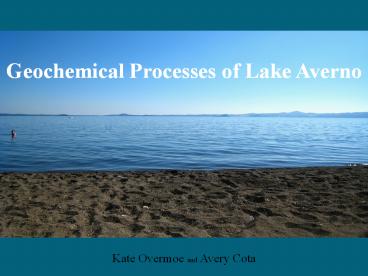Geochemical Processes of Lake Averno - PowerPoint PPT Presentation
Title:
Geochemical Processes of Lake Averno
Description:
Agricultural and illegal disposal of materials contribute to lake pollution. ... and analyzed by a gas chromatograph equipped with Thermal Conductivity Detector (TCD) ... – PowerPoint PPT presentation
Number of Views:84
Avg rating:3.0/5.0
Title: Geochemical Processes of Lake Averno
1
Geochemical Processes of Lake Averno
Kate Overmoe and Avery Cota
2
Background
- Lake Averno is located in NW sector of the Campi
Flegrei Volcanic District. - 15km west of Naples, Italy.
- Maximum depth of lake is 33m.
- Circumference of lake is 3.2km.
- No natural outlet.
S. Caliro et al., 2008. Geochemical and
biochemical evidence of lake overturn and fish
kill at Lake Averno, Italy. J. Volcanol.
Geotherm. Res. 178 (305-316), 2.
3
Lake Averno
- Lake Averno represents an outcropping of the
water table that is feed directly by meteoric
water. - Agricultural and illegal disposal of materials
contribute to lake pollution. - Previous studies suggest that an active magma
source may still contribute to the heat and
deep fluid release into the Campi Flegrei
District.
http//faculty.uml.edu/nelson_eby/Field20trip20p
hoto20essays/IGC202004/IGC202004.htm
4
Fish Kill Event
- Fish kills recorded January 2002, February 2003,
and February 2005. - Likely to have occurred throughout history.
- Journal concentrates on two surveys conducted
February and October 2005. - Following fish kill event February 2005, the
media linked the cause of the event to volcanic
sources. These accusations triggered geochemical
investigations of Lake Averno to identify
conditions at which this overturn and fish kill
event took place. - The February 2005 survey was conducted 3 days
following the event.
5
Methods
- Surveyed vertical profiles of the unstratified
water column (Feb.) and the stratified water
column (Oct.). - A multiparameter probe (Hydrolab multiprobe) was
used to collect temperature, Eh and pH data. - Water samples were collected by pumping water to
surface by means of a manual vacuum pump, keeping
the pressure difference within 0.2 atm. - Partial pressure of gases (CO2, N2, O2, Ar, CH4,
He, H2S) were collected in pre-evacuated vials
and analyzed by a gas chromatograph equipped with
Thermal Conductivity Detector (TCD).
6
The Results
- February 11, 2005
- October 27,2005
io.uwinnipeg.ca
7
The Results
October 27,2005
Depth (m) T (C) pH SO4 HCO3 pO2 pCH4 pCO2 pH2S
1 20.72 8.82 178 368 135 0.3 1.8 0
3 20.55 8.84 179 362 4.8 0.4 3.8 0
6 19.99 8.83 177 380 67.8 0.2 1.5 0
9 12.4 7.56 166 416 0.5 51.7 8.9 0
12 9.53 7.57 164 401 0.9 51.7 8.4 0
15 9.12 7.59 164 400 0.6 52.2 8.2 0
18 9.07 7.53 171 430 0 113.8 29.3 2.68
21 9.07 7.54 164 402 0.2 125.1 9.1 0
24 9.06 7.55 162 427 0 131 9.3 0
27 9.06 7.56 163 422 0 140 12.3 0.11
30 9.05 7.57 165 418 0 136.8 10 0.02
33 9.42 7.05 99 725 0 1026 42.2 4.56
8
The Results
Sulfate reduction SO42- organic matter ? H2S
2 HCO3-
9
The Results
Carbonate reduction CO2 4H2 ? CH4
2H2O Acetate fermentation CH3COO- H ? CH4
CO2
10
The Results
Fishkill caused by seasonal overturn
io.uwinnipeg.ca
11
Our Results
Initial Conditions
Resulting Conditions
Phase SI logIAP log KT
Anhydrite -2.14 -6.49 -4.35 CaSO4
Aragonite 1.01 -7.3 -8.31 CaCO3
Calcite 1.15 -7.3 -8.46 CaCO3
CH4(g) -7.72 -10.54 -2.82 CH4
CO2(g) -3.35 -4.77 -1.42 CO2
Dolomite 2.35 -14.64 -16.99 CaMg(CO3)2
Fluorite -0.35 -11 -10.65 CaF2
Gypsum -1.91 -6.49 -4.58 CaSO42H2O
H2(g) -25.64 -28.77 -3.13 H2
H2O(g) -1.62 0 1.62 H2O
Halite -5.15 -3.58 1.57 NaCl
N2(g) -4.35 -7.6 -3.25 N2
O2(g) -5.37 -8.23 -2.86 O2
Phase SI logIAP log KT
Anhydrite -2.08 -6.43 -4.34 CaSO4
Aragonite -0.5 -8.74 -8.24 CaCO3
Calcite -0.34 -8.74 -8.4 CaCO3
CH4(g) -7.85 -10.54 -2.7 CH4
CO2(g) -2.11 -3.33 -1.22 CO2
Dolomite -0.89 -17.52 -16.63 CaMg(CO3)2
Fluorite -0.09 -10.94 -10.85 CaF2
Gypsum -1.83 -6.43 -4.6 CaSO42H2O
H2(g) -23 -26.06 -3.06 H2
H2O(g) -2.02 0 2.02 H2O
Halite -5.11 -3.57 1.54 NaCl
N2(g) -4.4 -7.6 -3.19 N2
O2(g) -5.5 -8.23 -2.73 O2
- Drop in Calcite to a nearly saturation level
- Water becomes more dense than the bottom layers
- Allowing turnover to occur due to seasonal
differences
12
Our Results
Initial Conditions Resulting
Conditions
Phase SI logIAP log KT
Anhydrite -2.06 -6.4 -4.34 CaSO4
Aragonite -0.33 -8.58 -8.25 CaCO3
Calcite -0.17 -8.58 -8.41 CaCoO3
CH4(g) -4.17 -6.9 -2.72 CH4
CO2(g) -1.41 -2.67 -1.26 CO2
Dolomite -0.75 -17.46 -16.71 CaMg(CO3)2
Fluorite 0.24 -10.56 -10.81 CaF2
Gypsum -1.81 -6.4 -4.59 CaSO42H2O
H2(g) -22.1 -25.18 -3.08 H2
H2O(g) -1.94 0 1.94 H2O
H2S(g) -7.12 -7.93 -0.81 H2S
Halite -5.06 -3.52 1.54 NaCl
N2(g) -4.75 -7.96 -3.21 N2
NH3(g) -7.46 -5.36 2.1 NH3
O2(g) -44.57 -47.33 -2.76 O2
Sulfur 8.9 14.17 5.27 S
Phase SI logIAP log KT
Anhydrite -2.08 -6.44 -4.36 CaSO4
Aragonite 0.4 -7.93 -8.34 CaCO3
Calcite 0.55 -7.93 -8.48 CaCO3
CH4(g) -4.04 -6.9 -2.86 CH4
CO2(g) -1.71 -3.18 -1.47 CO2
Dolomite 0.93 -16.16 -17.09 CaMg(CO3)2
Fluorite 0 -10.6 -10.6 CaF2
Gypsum -1.86 -6.44 -4.58 CaSO42H2O
H2(g) -23 -26.15 -3.15 H2
H2O(g) -1.51 0 1.51 H2O
H2S(g) -7.38 -8.38 -1 H2S
Halite -5.1 -3.52 1.58 NaCl
N2(g) -4.7 -7.96 -3.26 N2
NH3(g) -6.19 -4.42 1.77 NH3
O2(g) -37.19 -40.08 -2.89 O2
Sulfur 9.74 14.62 4.88 S
- Increase in Calcite to slightly oversaturated
- Water becomes less dense than surface waters
- Allowing a turnover to occur due to geothermic
activity
13
Questions?































